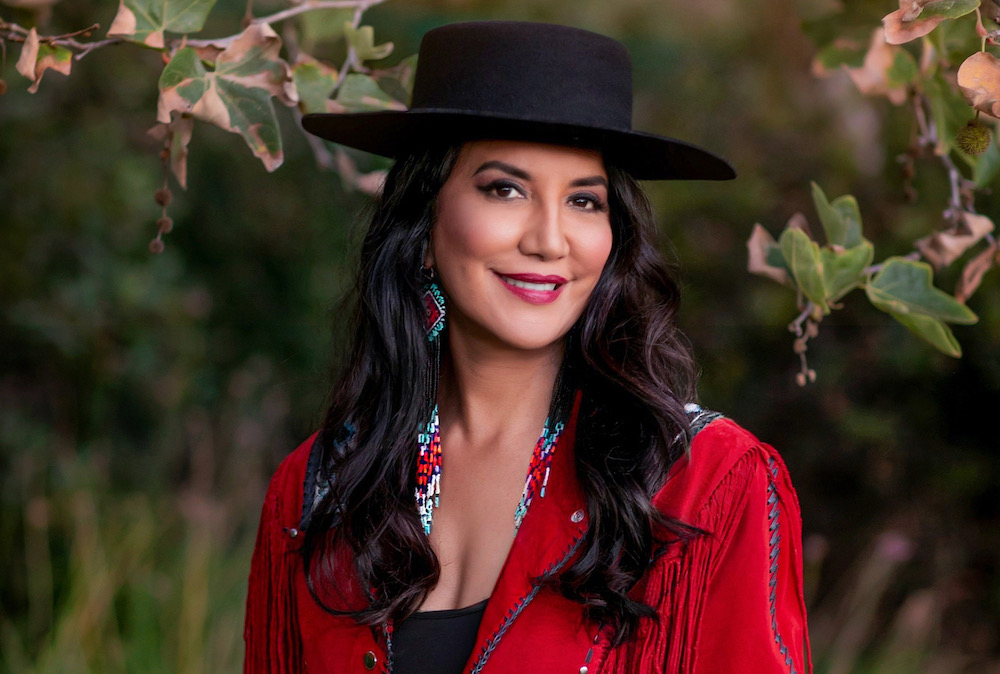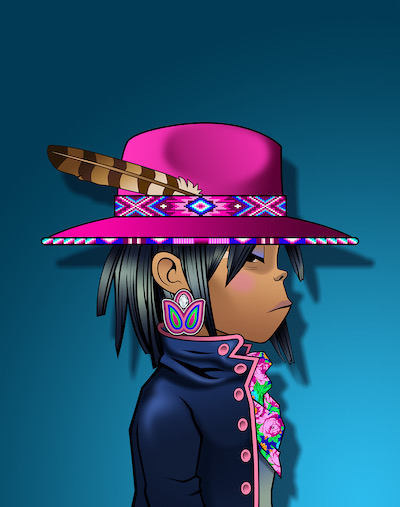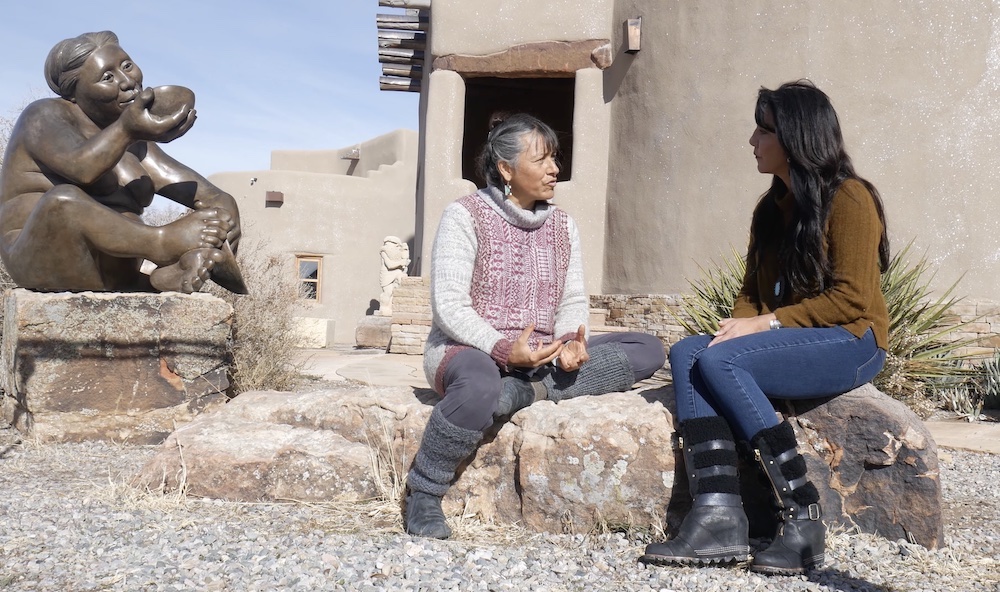
- Details
- By Tamara Ikenberg
- Indigenous Entrepreneurs
In the 1850s, the streets of downtown San Diego’s Gaslamp Quarter were dotted with signs saying: ‘Indians: $25 a head. Dead or Alive.”
Native Americans couldn’t even take a walk or window shop, much less own a business.
Nearly two hundred years later, towards the end of 2023, Ruth-Ann Thorn, a member of the Rincon Band of Luiseño Indians, opened the latest location in her group of Exclusive Collections galleries in the formerly Native-free zone.
“I am the first and only Native American sole proprietor that has ever opened anything in the Gaslamp,” said Thorn, who graces the cover of the current issue of News From Native California magazine. “On one hand I'm so proud. On the other hand, I'm very sad because it's taken us this long. But here we are.”
Thorn has claimed the space with panache, presenting a sleek and welcoming space bursting with modern art, including the work of Indigenous artists Jason Salazar (Mescalero Apache) and Thorn’s mother and business partner, Gloria Lee.
From running drugs over the border as a desperate teen, to running a series of sensational galleries, Ruth Ann Thorn’ story is one of resilience, resourcefulness and hustle.
The stylish, sophisticated gallerist with an eagle eye for amazing art owns seven galleries and has been in the art biz for 27 years. She is also deeply entrenched in the community, working closely with Indigenous nonprofit organizations including Native Like Water, and producing online series promoting art and Native culture.
Exclusive Collections’ offerings reflect how relevant and respected she is in the art world.
For instance, Thorn is one of a handful of dealers authorized to sell the work of Theodor Geisel, who is better known as Dr. Seuss. Geisel was a longtime resident of La Jolla, a southern California beach community. The gallery just concluded Grinchmas, a seasonal Seussian celebration highlighting the art of “The Grinch Who Stole Christmas.”

“I love carrying Dr. Seuss because a lot of people are really intimidated by coming into a gallery, but nobody's intimidated by Dr. Seuss. People love it, collect it, buy it, and it's a big pull. It welcomes everybody from all generations,” Thorn said. “Everybody knows that he was an illustrator and he was a writer for children. But many people don't understand what a brilliant artist he was.”
In addition to images of familiar characters like Thing 1 and Thing 2 and The Cat in the Hat, Exclusive Collections also carries some of his more abstract pieces, giving a more expansive view of his talent.
The gallery is also known, of course, for its Indigenous art. And when Thorn puts the spotlight on Indigenous art, she really puts on a show.
In November, Exclusive Collections hosted a Native American group show in honor of Native American Heritage Month. The space sparkled with Native masterworks, including silver pieces from superstar Navajo jeweler Cody Sanderson, photos by Chemehuevi photographer Cara Romero, and Indigenized versions of the artpop virtual band Gorillaz by Mayan muralist Votan Ik.
Downtown streets were closed off for a celebration with Kumeyaay bird singers and representatives from Native nonprofits.
“We've always been diverse in our collections,” Thorn said. “We've always included Native American artists. But it's only really been in the last five or six years that Native artists are coming out of Santa Fe and willing to show in other galleries.
“It’s because of generational trauma that a lot of Native people who were in the arts felt like really their only game in town was two places: Santa Fe and Scottsdale. But now, they're starting to show in more cities, because you're getting a younger generation of prominent Native artists in different genres; sculpture, paintings, photography, even graffiti art.”
Running for her life
At the age of 15, Thorn received what she calls a “colorful” crash course in business.
“My first entrée into business was being a drug runner from Tijuana,” she said. “I used to bring cocaine across the border. That was my journey. I don't recommend it for anyone.”
The choice came from desperation. A homeless runaway, Thorn needed a way to support herself when she fled her artist mother and activist father.
“The reservations had no money. And so there were some difficulties in my family life even though my parents were divorced,” Thorn said. “In my teenage years, there was a lot of dysfunction on both sides.”
She survived the dangerous period in her life and emerged with an unexpected education.
“I learned probably everything that I needed to ever know about business from the drug trade,” Thorn said. “When you're 15, you're not really thinking about that, but you're learning about supply and demand, cost of goods, markup, And you're also learning about transportation problems, supply chain, wholesale retail.”
Those lessons didn’t mean much to her until she found herself in Hawaii at the age of 21 and landed her first gallery gig. Thorn, who never finished high school, earned her GED and was planning on attending University of Hawaii after working in the gallery during summer.
The college plans were quashed a couple weeks into her new job. Thorn decided she wanted to make a living as an art dealer, and the gallery owner assured her that real world gallery experience was much more valuable than college classes.
Thorn threw herself into learning every angle of the industry, and moved back to the US mainland in 1995.
With a little money saved from selling art, Thorn attempted to get a small-business loan to jumpstart her art dealing career.
“They literally laughed me out of the bank,” Thorn recalled. “So I just started on my own. I bootstrapped myself.”
To connect with collectors in the most cost-effective way, Thorn started putting on DIY pop-up shows in hotel meeting rooms. With a U-Haul full of consigned art, Thorn drove to hotels and endured eight-hour set-ups before meeting with clients.
“It was an incredible amount of physical work — total sweat equity,” she said. “My invitations were in black and white because I couldn't afford color printing. My very first pop up show was in a 500-square foot meeting room in an L.A. hotel. And I don't know what possessed me to think this was going to work, but it was the only thing I could afford.”
Who does that?
After three years of the pop-up strategy, an exhausted Thorn switched gears and found a space in La Jolla to open her first gallery. She partnered with her mother and the two worked 12-hour days seven days a week to make it work.
It was a gutsy move given her resources.
“I put every single bit of money that I had earned over three years into the buildout, into inventory, into lighting, into everything to open this gallery. And I had just enough money in the bank to pay one month's rent when I opened,” Thorn said. “Who does that? I had no investors, no backers, nothing.”
At the time, she thought she had no support, but 27 years later, she sees it differently.
“I did have investors. I did have backers. They were my ancestors,” she said. “I remember one day sitting at my desk, crying and just praying to the spirit and saying, ‘I've made the biggest mistake in my entire life.’ I mean, nobody was walking into the gallery.”
In that moment, she had a realization that made all the difference in her entrepreneurial journey.
“There will come a time, if you're doing something great, when you're going to be tested. And you're going to either throw in the towel or you're going to figure out what you're going to do. And in that moment of despair, I said, ‘Okay, Ruthann, you come from a long family of survivors. What are you going to do?’”
She and her mother returned to pop-ups and eventually met a leasing agent for San Diego’s upscale Fashion Valley mall, who asked Thorn if she wanted to open an Exclusive Collections gallery there.
“We were very successful at Fashion Valley. That was the game changer for us financially,” Thorn said.
She closed the La Jolla gallery and Fashion Valley became the anchor. Over the next two decades Thorn opened seven galleries in locations including Beverly Hills, the Forum Shops at Caesars Palace in Las Vegas and San Diego tourist hotspot Seaport Village. During that time Thorn also opened an artist management company called Crown Thorn Publishing.
Even as she continues to grow the gallery business, Thorn is pursuing her own art as a filmmaker. She has two online series, Art of the City and This Is Indian Country, a travel show she describes as “Anthony Bourdain meets Indian Country.”
 Ruth-Ann Thorn (on right) interviews Native American sculptor Roxanne Swentzell (Santa Clara Tewa) during an episode of Thorn’s online show Art of the City. (Photo: Screenshot)
Ruth-Ann Thorn (on right) interviews Native American sculptor Roxanne Swentzell (Santa Clara Tewa) during an episode of Thorn’s online show Art of the City. (Photo: Screenshot)
“I interview Native Americans from different areas and kind of dispel the myth that we are all the same and that we are not here; that we only exist in black-and-white photos,” Thorn said. “People always ask, ‘Are you an artist?’ I'm a filmmaker. So that's my art, and it always showcases talent in all different mediums and genres.”
Thorn, who also mentors emerging artists, has important advice for aspiring entrepreneurs about the kind of people they should align themselves with as they make their own business journey.
“You're building a tribe, and the tribe is only as strong as its weakest link. You want to bring people in that are going to shine. And don't be afraid for people to outshine you,” Thorn said. “I think my greatest success is putting aside my ego and hiring people that are smarter than myself.
“The biggest mistake a business owner can make is to surround themselves with people who know less than you because of your ego. You should hire brilliant people. Get them on your side.”
